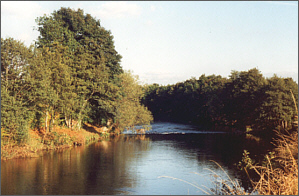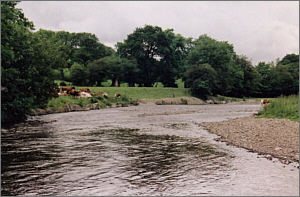Where to Fish
Sea Trout Fishing in the British Isles
|
|
So where should we start? The first thing to
note is that not all rivers in the British Isles are good
sea trout rivers. We might begin by asking, then, "What
makes a good sea trout river?"
This question may be taken in two ways. Does
it relate to a river's suitability as a sea trout
producing river or as a sea trout fishing river?
Naturally, to be a good sea trout river, in any sense, a
river must have the capacity to produce a good stock of sea
trout but not all sea trout producing rivers make good sea
trout fishing rivers.
Looking first at the characteristics likely to produce sea
trout, I would think that the best sea trout rivers would
meet the following criteria:
-
They would be free of any major obstacles
to allow the easy passage of returning sea trout. This
would include barriers, nets, estuary pollution,
predators, anglers etc.
-
They would have an abundance of
accessible spawning and nursery streams with suitable
spawning gravel and clean water. Although likely to be
acidic and lacking in trout food, they would have a
steady supply of clean, unpolluted water but not prone
to excessive winter flooding. It would be preferable if
the spawning conditions were less suited to salmon so
that the trout/sea trout would face less competition for
space on the spawning and nursery streams.
-
They would be relatively free from
predators e.g. sawbill
ducks, mink, eels etc.
-
They would likely be fairly acidic,
barren waters, but with an extensive system of nursery
streams, able to sustain a large number of juvenile
trout but unable to support a similarly large stock of
good sized brown trout, thus providing an incentive for
the majority of young fish, particularly the females, to
run to sea in order to find food.
-
The sea trout smolts would have a free, unhindered
passage on their seaward migration, with a minimum of
predation, pollution and obstruction. There should be no
salmon farms within a hundred miles of the river mouth.
-
There should be rich marine feeding in
the vicinity of the river mouth with a minimum of
exploitation of the sea trout's prey species, in
particular there should be no netting of sandeels.
For a light-hearted take on what makes a
sea trout, see
Should I Stay?
|
 |
 |
| The
River Earn at Templemill, Crieff |
A pool
on the River Cothi, Wales |
As to what makes a river a good sea trout fishing river,
that is perhaps more difficult to define. In addition to the
above qualities, I like a river with the following
characteristics:
-
It should be generally accessible to all
and reasonably priced.
-
It should be well managed, maintained and
policed, preferably by well qualified keepers.
-
It should have a good number of
deep holding pools, throughout its length, with plenty
of tree cover, not so much for fishing but to provide
sanctuary for the sea trout, particularly during
daylight hours.
-
Even at summer low levels, it would
have some streamy
water suitable for fly fishing - not rough water but with
enough flow to fish a fly without the need for hand-lining.
This streamy water may be quite shallow, even a foot of
water can hold fish at night. This streamy water would
ideally lie near some deeper holding water.
-
The river would flow through a series of
"pools" over a varied bed, with a mix of large stones,
shingle and gravel. The pools should have good tree
cover.
-
The river would not be subject to flash
floods, all too common nowadays with the afforestation of the upper
catchments of many rivers. It would clear reasonably quickly
after summer spates and would have a minimum of weed growth
of the kind now common in rivers where an excess of
agricultural fertiliser leaches into the river.
-
Ideally, the river should have an
entirely natural flow, with no man-made obstructions, no
hydro-electric schemes and no water abstraction of any
kind.
Few, if any, rivers are likely to meet all of
the above criteria but there are many rivers throughout the
British Isles which meet enough of them to qualify as good
sea trout fishing rivers. So where are they?
Sea Trout Fishing in England
In England, there are many excellent sea
trout rivers. The South West, in particular, has its share,
the most productive being the Teign, Fowey, Taw, Camel,
Dart, Tamar, Tavy, Avon (Devon), Axe and Lynher. In the
North West, the Lune, Ribble, Hodder, Kent, Cumbrian Esk and
Ehen are worthy of mention and, historically the most
productive of all, the Border Esk, although most of its sea
trout fishing lies in Scotland. The North East can boast of
several excellent, and, against the general run of things,
improving sea trout rivers, for example the Tyne and Wear,
with the Coquet and Yorkshire Esk having smaller, but
worthwhile, runs.
Sea Trout Fishing in Wales
Next we come to Wales, where sea trout, or
sewin, fishing vies with rugby as the national sport. There
are numerous sea trout rivers in all parts of Wales, the
most productive being the Towy (Tywi), Teifi, Dovey (Dyfi),
Clwyd, Conway (Conwy), Nevern, East and West Cleddau,
Rheidol, Mawddach, Glaslyn, Taf and Ogmore.
Sea Trout Fishing in Ireland
In Ireland, sea trout are taken in the
Currane/Waterville system, Kerry; the Cashla and
Ballynahinch, Connemara; the Feale, Limerick; the Owenduff
and Owenmore, Bangor; the Slaney, Wexford; the Bundorragha,
Erriff and Dawros, Ballinakill; the Munster Blackwater,
Lismore; the Boyne, Drogheda; the Bandon, Cork, to name only
a few of the main rivers. In Northern Ireland, we have the
Bush, Bann, Faughan, Roe, Derg, Finn and Foyle, all with
runs of sea trout.
Sea Trout Fishing in Scotland
Last but not least, there are
the Scottish rivers. Many of the rivers to the north and
west of the Great Glen were once noted sea trout fisheries - the Beauly,
Conon, Helmsdale, Brora, Naver, Dionard, Laxford, Gruinard,
Ewe, Torridon, Shiel, Ailort and Lochy, to name but a few.
Sadly, the runs, particularly in our north western rivers,
have declined with the growth of the salmon farms. Further
south and east, we have the Findhorn, Nairn, Deveron and,
perhaps best of all, the Spey; in the East, there are the
Ugie, Ythan, Don, Dee, South Esk and Earn; in mid Scotland
there are the Rivers Teith and Allan and, further west, the
Loch Lomond system, including the Rivers Leven and Endrick,
and the River Eachaig, flowing from Loch Eck; in the south, we have
the rivers running into the Solway Firth - the Border Esk,
the Nith, Annan and Cree. There is also good sea trout
fishing to be had on the Islands, particularly in Lewis,
Harris, the Uists, Orkney and Shetland. See
Scottish Salmon and Sea Trout Catches
For
information on sea trout fishing on some of the best
British Angling Associations see:
Angling Associations
For more maps and information
on sea trout rivers see:
British Sea Trout Rivers
Sea Trout Fishing in Scotland
|
|